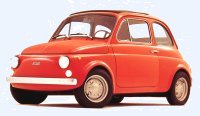The Fiat 500, or Cinquecento as it’s known, is much more than just a car. It’s a piece of history – and one that’s not so dissimilar to Rimini. They are both succesful products of the post-war economic miracle in Italy, they’re both much admired and imitated, and both have gone through peaks and troughs of popularity.
 The first Fiat 500 was actually produced in the mid 1930s, with design by the roman-born car-designer Dante Giacosa, but it was in the 40s and 50s that the car came into its stride, meeting the requirements for a cheap, small, and fuel efficient car for city-life. The post war period saw a massive migration from rural areas, particularly in the impoverished south, to cities like Milan, Rome, and Turin – all historic cities with plenty of small streets. It’s no surprise that it was in Italy, then, that one of the world’s most popular small cars was born (alongside the classic scooters that were also developed in this period).
The first Fiat 500 was actually produced in the mid 1930s, with design by the roman-born car-designer Dante Giacosa, but it was in the 40s and 50s that the car came into its stride, meeting the requirements for a cheap, small, and fuel efficient car for city-life. The post war period saw a massive migration from rural areas, particularly in the impoverished south, to cities like Milan, Rome, and Turin – all historic cities with plenty of small streets. It’s no surprise that it was in Italy, then, that one of the world’s most popular small cars was born (alongside the classic scooters that were also developed in this period).
From the 1950s to the 1970s the Fiat 500 came in various models, and was popular both in Italy and abroad, helping to make Fiat’s name as a major car-maker (enriching further the Agnelli family who had founded the company in Turin).
New models and changes in fashion led to the 500’s decline in the mid-late 70s, after which it was phased out of production. In 2007, though, Fiat recognised the huge power the brand still held in the marketplace and developed a new streamlined 500 – a world away from the original design. As I write this piece, Fiat are in talks with Chrysler in the United States to form an alliance which will see the Italian car maker try to relaunch the troubled motor industry by convincing the American market that small cars like the new 500 are the way forward. Time will tell if they’re succesful or not.
In the meantime, though, if you’re in Rimini you can head to the beautiful town of Sant’Arcangelo on the 21st of May to catch a gathering of classic Fiat 500’s on the road. The group Mio 500, classic car enthusiasts, will congregate in the town with their cars, before heading off on a tourist trail around the province of Rimini. It’s well worth catching this particular piece of Italian and automobile history – and you can check out Sant’Arcangelo at the same time!